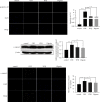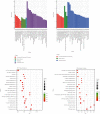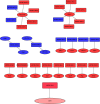Analysis of Function Role and Long Noncoding RNA Expression in Chronic Heart Failure Rats Treated with Hui Yang Jiu Ji Decoction
- PMID: 36704572
- PMCID: PMC9873466
- DOI: 10.1155/2023/7438567
Analysis of Function Role and Long Noncoding RNA Expression in Chronic Heart Failure Rats Treated with Hui Yang Jiu Ji Decoction
Abstract
Hui Yang Jiu Ji (HYJJ) decoction has been applied as a prescription of traditional Chinese medicine for the treatment of chronic heart failure (CHF). However, its comprehensive molecular mechanism remains unclear now. Our study aimed to explore the possible function and lncRNA-miRNA regulation networks of HYJJ on CHF induced by doxorubicin (DOX) in rats. Our study showed that HYJJ could recover cardiac function and alleviate myocardial injury of DOX-induced CHF. Besides, HYJJ had an effect on restraining myocardial apoptosis in CHF rats. Moreover, RNA-sequencing and bioinformatics analysis indicated that among a total of 548 significantly up- and down-regulated differentially expressed (DE) long noncoding RNA (lncRNA), 511 up- and down-regulated DE miRNAs were identified. Cushing's syndrome and Adrenergic signaling in cardiomyocytes were common pathways between DE-lncRNAs-enriched pathways and DE-miRNAs-enriched pathways. Finally, we observed a new pathway-MSTRG.598.1/Lilrb2 pathway with the HYJJ treatment; however, it needs further studies. In conclusion, this study provided evidence that HYJJ may be a suitable medicine for treating CHF. Moreover, several pivotal miRNAs may serve important roles in these processes by regulating some key miRNAs or pathways in CHF.
Copyright © 2023 Huan Zhang et al.
Conflict of interest statement
The authors declare that they have no conflicts of interest.
Figures









Similar articles
-
Comprehensive analysis of lncRNA-miRNA-mRNA networks during osteogenic differentiation of bone marrow mesenchymal stem cells.BMC Genomics. 2022 Jun 7;23(1):425. doi: 10.1186/s12864-022-08646-x. BMC Genomics. 2022. PMID: 35672672 Free PMC article.
-
Upregulation of let-7f-2-3p by long noncoding RNA NEAT1 inhibits XPO1-mediated HAX-1 nuclear export in both in vitro and in vivo rodent models of doxorubicin-induced cardiotoxicity.Arch Toxicol. 2019 Nov;93(11):3261-3276. doi: 10.1007/s00204-019-02586-4. Epub 2019 Sep 30. Arch Toxicol. 2019. PMID: 31570982
-
Effect of the traditional Chinese medicine Qi Teng Xiao Zhuo granules on chronic glomerulonephritis rats studied by using long noncoding RNAs expression profiling.Gene. 2020 Feb 20;728:144279. doi: 10.1016/j.gene.2019.144279. Epub 2019 Dec 9. Gene. 2020. PMID: 31821871
-
Evaluation of the effect of Shengxian Decoction on doxorubicin-induced chronic heart failure model rats and a multicomponent comparative pharmacokinetic study after oral administration in normal and model rats.Biomed Pharmacother. 2021 Dec;144:112354. doi: 10.1016/j.biopha.2021.112354. Epub 2021 Oct 28. Biomed Pharmacother. 2021. PMID: 34794233
-
[Progress in treatment of chronic heart failure in Western medicine and treatment strategies in traditional Chinese medicine].Zhong Xi Yi Jie He Xue Bao. 2010 Jan;8(1):7-14. doi: 10.3736/jcim20100102. Zhong Xi Yi Jie He Xue Bao. 2010. PMID: 20082751 Review. Chinese.
Cited by
-
Molecular Mechanism of Yangshen Maidong Decoction in the Treatment of Chronic Heart Failure based on Network Pharmacology, Molecular Docking, and Molecular Dynamics Simulations.Cell Biochem Biophys. 2024 Jun;82(2):1433-1451. doi: 10.1007/s12013-024-01297-7. Epub 2024 May 16. Cell Biochem Biophys. 2024. PMID: 38753250
-
Exploring the therapeutic mechanisms of heart failure with Chinese herbal medicine: a focus on miRNA-mediated regulation.Front Pharmacol. 2024 Nov 5;15:1475975. doi: 10.3389/fphar.2024.1475975. eCollection 2024. Front Pharmacol. 2024. PMID: 39564110 Free PMC article. Review.
References
-
- Testa G., Cacciatore F., Della-Morte D., et al. Role of permanent atrial fibrillation (AF) on long-term mortality in community-dwelling elderly people with and without chronic heart failure (CHF) Archives of Gerontology and Geriatrics . 2012;55(1):91–95. doi: 10.1016/j.archger.2011.06.003. [In eng] - DOI - PubMed
-
- Ponikowski P., Voors A. A., Anker S. D., et al. ESC Guidelines for the diagnosis and treatment of acute and chronic heart failure: the Task Force for the diagnosis and treatment of acute and chronic heart failure of the European Society of Cardiology (ESC)Developed with the special contribution of the Heart Failure Association (HFA) of the ESC. European Heart Journal . 2016;37(27):2129–2200. doi: 10.1093/eurheartj/ehw128. [In eng] - DOI - PubMed
Publication types
MeSH terms
Substances
LinkOut - more resources
Full Text Sources
Medical

